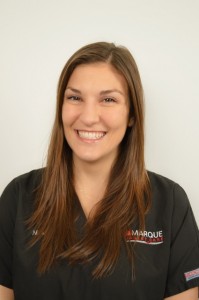
Tighten Up Your Knowledge on Botox by Nicole Kimball
 Botox is the well-known trade name for onabotulinumtoxinA, which is produced locally in Irvine, California by Allergan. It was initially used in the 1980s to treat eyelid spasms (blepharospasm). In 1987 a patient who was receiving Botox injections for her eyelid spasms happened to notice that the injections were decreasing her frown lines. She alerted her treating ophthalmologist, who then told her husband, a dermatologist. Together they conducted clinical research on the cosmetic use of Botox to reduce wrinkles. In 2002 the FDA approved Botox to be used for treatment of glabellar lines which are the wrinkles in between a person’s eyebrows. While the treatment of glabellar lines is the only FDA approved cosmetic use for Botox, there are various off-label uses for cosmetic treatments, many of which are the reduction of wrinkles on other areas of the face. Such areas prone to facial wrinkling include: forehead, corners of the eye (crow’s feet), lower eyelid, around the mouth (laugh lines), and the chin.
Botox is the well-known trade name for onabotulinumtoxinA, which is produced locally in Irvine, California by Allergan. It was initially used in the 1980s to treat eyelid spasms (blepharospasm). In 1987 a patient who was receiving Botox injections for her eyelid spasms happened to notice that the injections were decreasing her frown lines. She alerted her treating ophthalmologist, who then told her husband, a dermatologist. Together they conducted clinical research on the cosmetic use of Botox to reduce wrinkles. In 2002 the FDA approved Botox to be used for treatment of glabellar lines which are the wrinkles in between a person’s eyebrows. While the treatment of glabellar lines is the only FDA approved cosmetic use for Botox, there are various off-label uses for cosmetic treatments, many of which are the reduction of wrinkles on other areas of the face. Such areas prone to facial wrinkling include: forehead, corners of the eye (crow’s feet), lower eyelid, around the mouth (laugh lines), and the chin.
While Botox is most known for its cosmetic uses, the majority of treatments using Botox are non-cosmetic. Only four non-cosmetic uses of Botox are currently FDA approved, the rest are off-label. The FDA approved uses are to treat blepharospasm (excessive sweating in the armpits), involuntary muscle contractions in the neck, and crossed eyes. The off-label uses of Botox far outnumber the FDA approved uses. Botox can help treat conditions relating to many different disorders, some of which include: jaw pain, hiccups, constipation, drooling, overactive bladder, migraine and cluster headaches, facial spasms, stutters, and back pain. Treating some of those, and many other, conditions with Botox allows patients to avoid surgical interventions and more invasive treatments due to Botox’s effectiveness and low risk profile. Most medical specialties have found a use for Botox in the treatment of patients. Additional treatments with Botox are currently being studied in clinical trials and more uses are found all the time.
The information provided is for general interest only and should not be misconstrued as a diagnosis, prognosis or treatment recommendation. This information does not in any way constitute the practice of medicine, or any other health care profession. Readers are directed to consult their health care provider regarding their specific health situation. Marque Medical is not liable for any action taken by a reader based upon this information.
